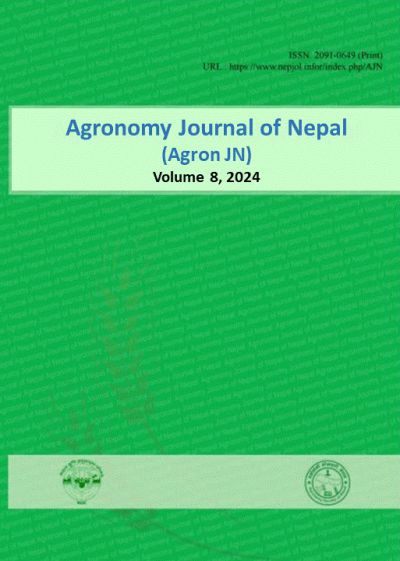Response of Nepalese Rice Landraces to Brown Spot [Bipolaris oryzae (Breda de Haan) Shoemaker] at Rampur, Chitwan, Nepal
DOI:
https://doi.org/10.3126/ajn.v8i1.70892Keywords:
AUDPC, seed-born disease, rice genotypes, resistant genotypesAbstract
Brown spot disease, caused by the fungus Bipolaris oryzae, is a common foliar affliction in rice plants, impacting agricultural yields worldwide. A field experiment was conducted to identify brown spot resistant landraces at Rampur, Chitwan during June to November, 2018. A set of 54 rice genotypes comprising of 52 landraces and two checks (resistant and susceptible) were evaluated for resistance to the disease under field condition in alpha lattice design with three replicates. Area under disease progress curve (AUDPC) values varied significantly among the genotypes. Of the tested 54 genotypes, nine genotypes were found moderately resistant, 38 genotypes susceptible and seven genotypes were found highly susceptible. The maximum incidence (64.9%) of pathogen was found in seed of Hodbachhi followed by Sankharika (64.15%). The minimum average incidence of pathogen was found in check Sabitri (4.05%), which was as par with other 28 genotypes. The yield attributing characters were highly significant among the genotypes. Highest grain yield (1.55 t ha-1) was obtained from Ghusara (1.51 t ha-1) followed by Lalbachhi. Lowest grain yield was obtained from Ghuyeni Saro (0.21 t ha-1) followed by Jaguli Mansuli (0.25 t ha-1). All the yield and yield attributing characters were negatively correlated with AUDPC. Seed-borne infection after harvest was highly significant among the genotypes. The results revealed that among the screened genotypes most of the landraces of rice are susceptible to brown spot.
Downloads
Downloads
Published
How to Cite
Issue
Section
License
Copyright (c) 2024 Agronomy Society of Nepal (ASoN)

This work is licensed under a Creative Commons Attribution-NonCommercial 4.0 International License.
ASON permits for free use, distribution and reproduction in any medium if the original work is properly cited and not used for commercial purposes.




